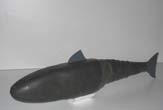RoboSalmon to Spy on Fish

RoboSalmon, an underwater robot meant to spy on the real fish, is being developed at Glasgow University.
The robot has a built-in camera to broadcast images of real fish back to the operators of the device. Zoologists will use RoboSalmon to monitor various fish species in their natural habitat.
A key feature of RoboSalmon is its propulsion system. Since the robot will use its fins and tail for movement, it will be able to move through the water in a way that is more natural for aquatic creatures. Propellers make an unnatural noise that disturbs fish; RoboSalmon's biomimetic characteristics should help it blend in (see photo).
Robot evolution (biomimetic or not) does not follow the course of natural evolution. It turns out the the RoboSalmon is a direct descendant of the SHARC - Submersible Hybrid Autonomous Rover Craft.
The SHARC was also designed as a biomimetic system, using its tail to move around (see photo).
I can't resist stories like this (in the case of this story, I see in my mind's eye the robosalmon returning to Glasgow to spawn). In his 2002 story "Slow Life," science fiction author Michael Swanwick writes about robot fish who help explore distant worlds:
The Mitsubishi turbot wriggled, as if alive. With one fluid motion, it surged forward, plunged, and was gone. Lizzie switched over to the fishcam. Black liquid flashed past the turbot's infrared eyes. Straight away from the shore it swam, seeing nothing but flecks of paraffin, ice, and other suspended particulates... (Read more about the Mitsubishi turbofish)
Robotic fish are all the rage now; if you like robofish, you'll enjoy these news items:
Sign up for the Live Science daily newsletter now
Get the world’s most fascinating discoveries delivered straight to your inbox.
Via The Herald .
(This Science Fiction in the News story used with permission from Technovelgy.com - where science meets fiction.)
- Images: Freaky Fish
- Images: Venomous Fish
- All About Fish









